favicongohere


Please use the navigation menu at bottom the Page
MenuGoHere
“The Foundation of Amherst - Clues Beneath Our Feet”
Ellicott Creek flows over the Onondaga Escarpment in Glen Park.
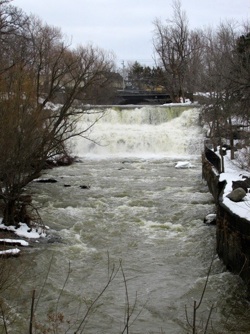


Sunday Walk and Talk Series - March 15, 2015 - "The Foundation of Amherst - Clues Beneath Our Feet" Approximately 25 participants enjoyed the walk led by Dr. Richard Laub, a geologist and paleontologist. Richard Laub, who has served as curator of geology at the Buffalo Museum of Science for 38 years, discussed with attendees of the walk, Amherst’s pattern of development that can be traced to movements within the Earth’s crust.
Dr. Laub explained history of the escarpment and why it is where it is.
Dr. Laub concludes his presentation by discussing fossils from the Onondaga Limestone.





“Migratory Birds at Amherst State Park”
“Sunday Walk and Talk” April 12, 2015 at Amherst State Park. The topic was “Migratory Birds at Amherst State Park” led by Jerry Thurn, Field guide for the Audubon Center. Approximately 35 participants enjoyed the walk. The “Sunday Walks and Talks” programs are sponsored by the Amherst Conservation Advisory Council.
“Walks and Talks” Program Coordinator, Roselyn Laub, introduces Jerry Thurn to the group of participants.
Folks gather on the bridge over Ellicott Creek
to discuss water birds found in the park.
One very familiar migratory bird was singing it’s heart out. Do you know what it is?
2015 Activities at Amherst State Park

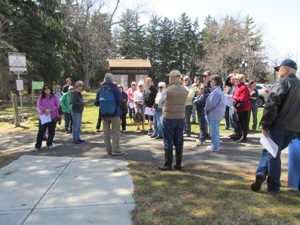

“Concert at Amherst State Park”

“Mill Stone Display at Amherst State Park”

“2015 Front Gardens at Amherst State Park”

“Monarch Butterfly Conservation Area”
New informational signage to explain the Monarch Butterfly life cycle and plants that attract butterflies and pollinators.

A concert by the “Friends of Harmony”, sponsored by the Town of Amherst Youth and Recreation Department, was held on July 8, 2015. It was very well attended and due to it’s success, future concerts will be held.
Before the Sisters of St. Francis acquired the property in the 1900’s, it was home to a mill complex built by John Reist. The area around Ellicott Creek and the falls was home to many mills in the 1800’s.
These three mill stones are on display to show some of the history of Amherst State Park. They where donated to the park from Franklinville, New York.
To expand this historic display, we are looking for a large grist mill stone and/or a large flour mill stone. If you know the location of one of these mill stones or which to donate one to Amherst State Park, email us at AmherstStatePark@roadrunner.com.
You can start your own Monarch Butterfly Conservation Area in your backyard.
These Western New York native wildflowers support pollinators such as threatened Monarch Butterflies.
Anise Hyssop
Black-eyed Susan
Common Milkweed
Lanceleaf Coreopsis
New England Aster
Ox-eye Sunflower
Purple Coneflower
Still Goldenrod
Swamp Milkweed
White Yarrow
Wild Bergamot
Entrance Gardens at Amherst State Park, Probably the most beautiful they have been. THANK YOU! volunteers and students from the Town of Amherst Y.E.S. Program (Youth Engaged in Service).


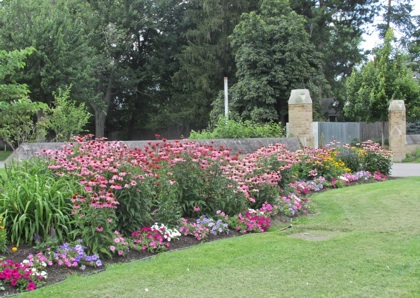

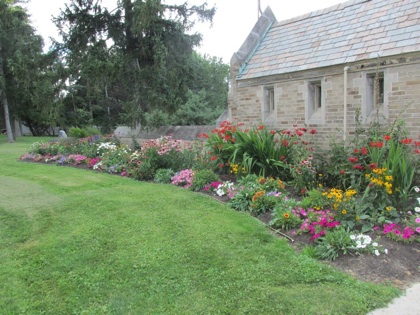
The Monarch Butterfly Conservation Area is at the bottom of the slope where the drainage channel joins Ellicott Creek.
There are many other areas in Amherst State Park that have Milkweed and Joe Pye Weed plants growing.
These two plants are very important to the survival of the Monarch Butterfly. Look for them as you walk through the park.
Joe Pye Weed will attract Monarchs other butterflies and other pollinators (insects).


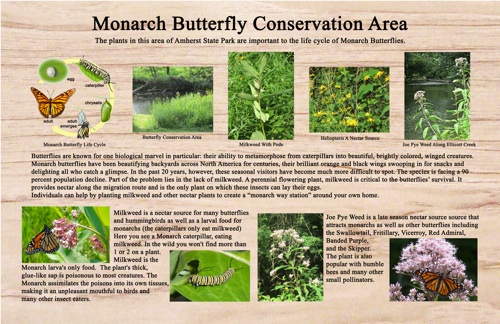
Butterfly Conservation Area near Ellicott Creek
Milkweed pods ripen in late summer. The plant is necessary
for Monarch Butterfly survival as it is the only plant the
Monarch Caterpillar eats.
Heliopteris in Ellicott Creek Butterfly Conservation Area.




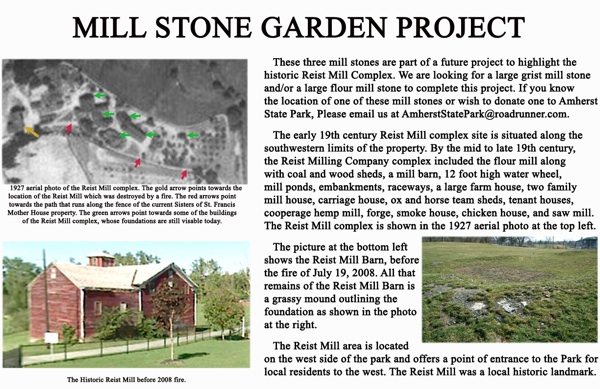



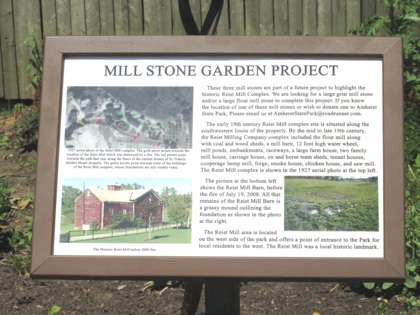
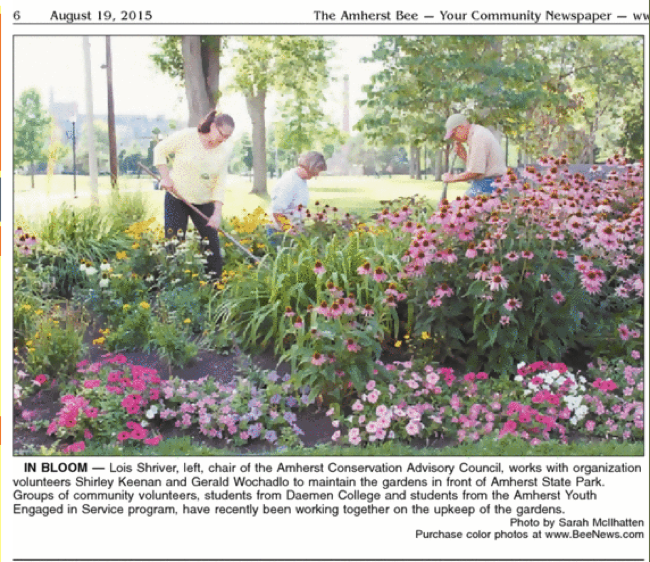
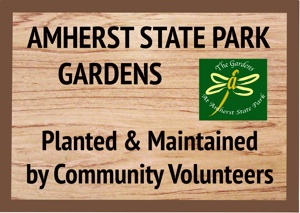
20 inch diameter Mill Stone.
Note square center opening.
25 inch diameter Mill Stone.
20 inch diameter Mill Stone.
Note square center opening.
Mill Stone Display Sign
Mill Stone Display

“Volunteers at Amherst State Park”
One of two signs at either end of the
Front Gardens.
The Gardens at Amherst State Park are maintained by community volunteers.
If you would like to help at the Gardens or with other projects in the park.
Please email us at AmherstStatePark@roadrunner.com


Monarch Butterflies in Amherst State Park
Monarch Butterflies have been seen by many visitors to the park this year. Some have even observed a
Monarch caterpillar on it’s only food source - the milkweed plant. These photos, taken in August
and September of 2015, are from various areas of the park.
A nice group of milkweeds in the meadow area,
just west of the bridge over Ellicott Creek.
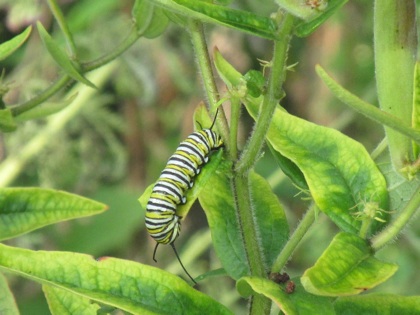



A very tiny Monarch egg was found under a milkweed leaf. When the egg hatches, the tiny caterpillar begins to eat the leaf. This is normally their only food source and provides them with the toxin that makes them very unappetizing to birds. You may want to grow some milkweed plants to provide a Monarch habitat.
A beautiful Monarch caterpillar munches on some butterfly weed.
Guess they will eat that, too. This one was about 2 inches
long and probably ready to make it’s chrysalis.
This Monarch butterfly, photographed in September, will probably make the long journey to Mexico. It will have several stop-overs during it’s trip to rest and feed. Monarchs normally live for about 4 weeks, but the group that makes the long to the Mexican wintering grounds are called “super Monarchs”.They live for about six weeks, long enough to complete the journey to Mexico.

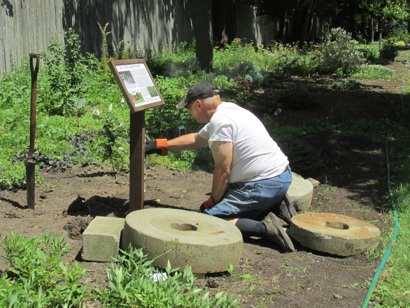
Jerry Wochadlo, a volunteer at Amherst State Park, gets ready to place the millstones for the display. He also made the sign for the display
Jerry makes sure that the sign will be straight.
Winter at Amherst State Park




Cross-Country skiers enjoy a day at Amherst State Park.
Ellicott Creek is always beautiful in the winter.
Yup. That’s one of the benches along the sidewalk. No sitting in the sun today.
February 22, 2015

Williamsville North High School at Amherst State Park


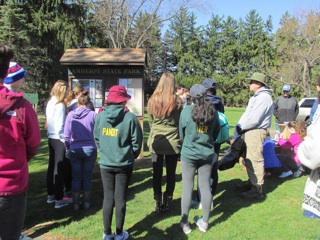
Making sure all the instructions will be followed.
April 25, 2015. Williamsville North High School students prepare for the Ellicott Creek cleanup.
The entire group of hard working students stop for a group shot. Nice job, everyone.

Daemen students at Amherst State Park
Head Cross Country Coach, Jessica Gorski (second from the right), lends a hand.
Daemen students begin the task of cleaning up the Front Gardens following a difficult winter
Group photo time.Thanks so much for your hard work..



Daemen Students Front Garden Cleanup - May 2, 2015


Spring 2015 at Amherst State Park

Y.E.S. Students work on Front Gardens

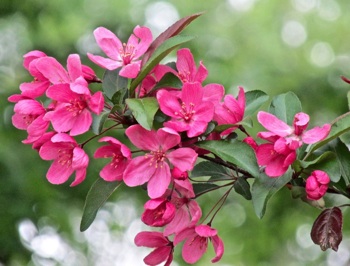




Early May blooms and Ellicott Creek residents at Amherst State Park
A butterfly attracted to the sweet fragrance.
One of the resident Great Blue Herons.
Prairie Fire Crabapple blossoms.


Those buckets are heavy! Ellen Banks, a member of the Amherst Conservation Council, ponders what needs to be done next.
Amherst Youth Engaged in Service members returned to Amherst State Park on June 25, 2015 and
planted 120 petunias along the border of the “Front Gardens”.
May 2015, Amherst Y.E.S. (Youth Engaged in Service) students carry buckets of compost
to spread on the “Front Gardens“ at Amherst State Park.
What a beautiful job.
Well done everyone.
Moving right along. The Students finished the project in 1 1/2 hours.
One of the YES volunteers plants a petunia. Perfect spacing.
A small group with a lot of heart. Hard workers, all. The students moved three large piles of compost in 1 1/2 hours and were wonderful to work with. Thanks to everyone and to Amy for chaperoning the students.





Deamen Students at Amherst State Park
Sunday September 13, 2015, student volunteers from Daemen College and their professor, Rebecca Besch,
spread 5 loads of wood chips behind the historic front wall and around the shed to help control the growth of weeds.
It was hard work, but they had fun and the result was awesome.

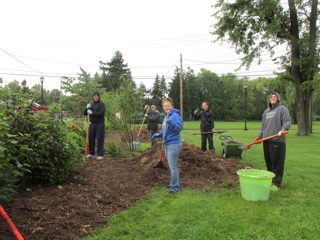


One pile done, second one in progress and the third waiting on down the line. It was still trying to rain and the grass was soaked. So much for dry shoes
Looks like they are having a good time.
The Daemen students and Rebecca pose for a group photo. Thanks you ao very much for all the help you have provided at Amherst State Park. (Oh, and Lois is the one in the orange jacket.) Thanks, Jerry, for taking the photo.







